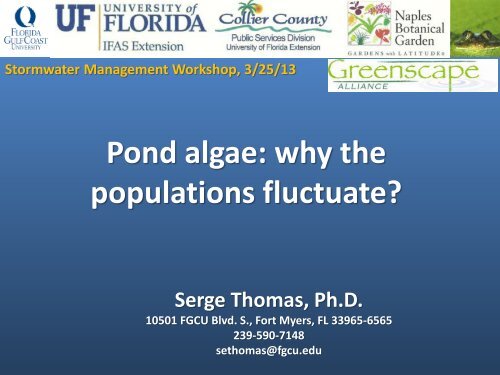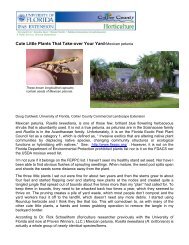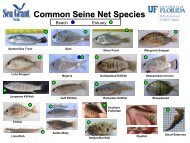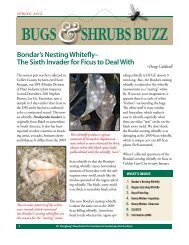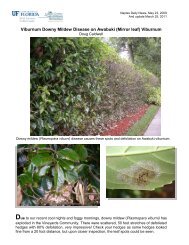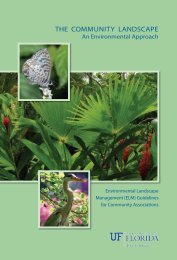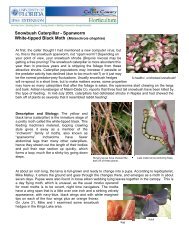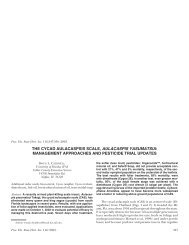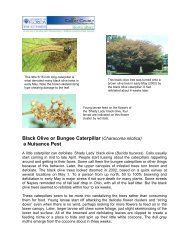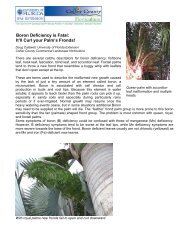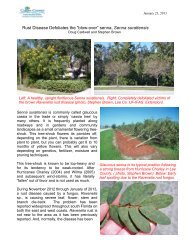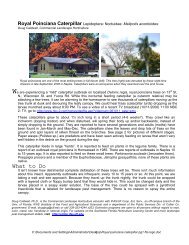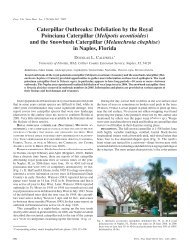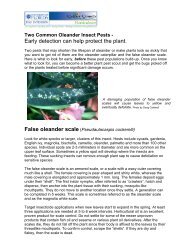Pond algae: why the populations fluctuate?
Pond algae: why the populations fluctuate?
Pond algae: why the populations fluctuate?
You also want an ePaper? Increase the reach of your titles
YUMPU automatically turns print PDFs into web optimized ePapers that Google loves.
Stormwater Management Workshop, 3/25/13<br />
<strong>Pond</strong> <strong>algae</strong>: <strong>why</strong> <strong>the</strong><br />
<strong>populations</strong> <strong>fluctuate</strong>?<br />
Serge Thomas, Ph.D.<br />
10501 FGCU Blvd. S., Fort Myers, FL 33965-6565<br />
239-590-7148<br />
sethomas@fgcu.edu
What are <strong>algae</strong>?
Differentiation by size:<br />
Macro <strong>algae</strong><br />
Large <strong>algae</strong> not requiring a microscope to be seen.<br />
Composed of different algal cells which have different<br />
functions and shapes.<br />
Example is Chara vulgaris (stonewort)
Differentiation by size:<br />
Micro <strong>algae</strong><br />
Microscopic <strong>algae</strong> requiring a microscope to be<br />
seen.<br />
Can be living alone or associated with o<strong>the</strong>r <strong>algae</strong><br />
(=colonies).<br />
Colonies can have various spatial configurations
Differentiation by size:<br />
Micro <strong>algae</strong><br />
Microscopic <strong>algae</strong> requiring a microscope to be<br />
seen.<br />
Can be living alone or associated with o<strong>the</strong>r <strong>algae</strong><br />
(=colonies).<br />
Colonies can have various spatial configurations<br />
A few cells can be specialized
Differentiation by color:<br />
Green:<br />
Yellow-brown (Diatoms):<br />
Red:<br />
Blue green:<br />
Eukaryotes<br />
Prokaryotes
Differentiation by location:<br />
Open water <strong>algae</strong> (limnetic or pelagic)=<br />
phytoplankton<br />
Bottom <strong>algae</strong> (attached): Periphyton<br />
Can be attached on bottom or not. If not attached,<br />
can be resuspended by water mixing.<br />
Can be attached to macro<strong>algae</strong> (Chara) or aquatic<br />
plants to “steal” <strong>the</strong>ir nutrients.
Role of <strong>algae</strong>:<br />
Photosyn<strong>the</strong>sis (primary producers):<br />
CO 2 + H 2O C(H 2O) + O 2<br />
Fuel <strong>the</strong> food chain<br />
Give or take oxygen<br />
Carnivores III<br />
Carnivores II<br />
Carnivores I<br />
Primary producers<br />
Grazers
Role of <strong>algae</strong>:<br />
Photosyn<strong>the</strong>sis (primary producers):<br />
CO 2 + H 2O C(H 2O) + O 2<br />
Fuel <strong>the</strong> food chain<br />
10%<br />
10%<br />
10%<br />
10%<br />
Carnivores III<br />
Carnivores II<br />
Carnivores I<br />
Primary producers<br />
Grazers
Role of <strong>algae</strong>:<br />
Photosyn<strong>the</strong>sis (primary producers):<br />
CO 2 + H 2O C(H 2O) + O 2<br />
Fuel <strong>the</strong> food chain (bottom up control)<br />
10%<br />
10%<br />
10%<br />
10%<br />
Carnivores III<br />
Carnivores II<br />
Carnivores I<br />
Primary producers<br />
Grazers
What controls <strong>the</strong> <strong>algae</strong>?<br />
Photosyn<strong>the</strong>sis (primary producers):<br />
CO 2 + H 2O C(H 2O) + O 2<br />
Light - Temperature
What controls <strong>the</strong> <strong>algae</strong>?<br />
Photosyn<strong>the</strong>sis (primary producers):<br />
CO 2 + H 2O C(H 2O) + O 2<br />
Light - Temperature<br />
Nutrients:<br />
macro nutrients: Phosphorus, Nitrogen, CO 2<br />
micro nutrients: Iron, copper …
What controls <strong>the</strong> <strong>algae</strong>?<br />
Photosyn<strong>the</strong>sis (primary producers):<br />
CO 2 + H 2O C(H 2O) + O 2<br />
Light - Temperature<br />
Nutrients:<br />
macro nutrients: Phosphorus, Nitrogen, CO 2<br />
micro nutrients: Iron, potassium…<br />
Competition among <strong>algae</strong> and w/ <strong>the</strong> aquatic<br />
plants
What controls <strong>the</strong> <strong>algae</strong>?<br />
Photosyn<strong>the</strong>sis (primary producers):<br />
CO 2 + H 2O C(H 2O) + O 2<br />
Light - Temperature<br />
Nutrients:<br />
macro nutrients: Phosphorus, Nitrogen, CO 2<br />
micro nutrients: Iron, potassium…<br />
Competition among <strong>algae</strong> and w/ <strong>the</strong> aquatic<br />
plants
The top of <strong>the</strong> food chain can control<br />
<strong>algae</strong>: top-down control<br />
10%<br />
10%<br />
10%<br />
10%<br />
Carnivores III<br />
Carnivores II<br />
Carnivores I<br />
Primary producers<br />
Grazers
Let’s consider a freshly excavated pond…<br />
Low nutrients in water = no phytoplankton
Let’s consider a freshly excavated pond…<br />
Low nutrients in water = no phytoplankton = clear water
Let’s consider a freshly excavated pond…<br />
Low nutrients in water = no phytoplankton = clear water<br />
Light reaches Lake bed
Let’s consider a freshly excavated pond…<br />
Low nutrients in water = no phytoplankton = clear water<br />
Light reaches Lake bed<br />
Some nutrients in <strong>the</strong> lake bed
Let’s consider a freshly excavated pond…<br />
Low nutrients in water = no phytoplankton = clear water<br />
Light reaches Lake bed<br />
Rooted<br />
aquatic<br />
vegetation<br />
Some nutrients in <strong>the</strong> lake bed
Let’s consider a freshly excavated pond…<br />
Low nutrients in water = no phytoplankton = clear water<br />
Light reaches Lake bed<br />
Rooted<br />
aquatic<br />
vegetation<br />
Rooted aquatic vegetation<br />
and attached <strong>algae</strong><br />
intercept <strong>the</strong> nutrients<br />
before getting to <strong>the</strong><br />
water<br />
Attached <strong>algae</strong><br />
Some nutrients in <strong>the</strong> lake bed
Let’s consider a freshly excavated pond…<br />
Low nutrients in water = no phytoplankton = clear water<br />
Light reaches Lake bed<br />
Rooted<br />
aquatic<br />
vegetation<br />
Rooted aquatic vegetation<br />
and attached <strong>algae</strong><br />
intercept <strong>the</strong> nutrients<br />
before getting to <strong>the</strong><br />
water<br />
attached <strong>algae</strong><br />
Some nutrients in <strong>the</strong> lake bed
Most of everywhere in <strong>the</strong> world, such a low<br />
nutrient pond should look like that:
Most of everywhere in <strong>the</strong> world, such a low<br />
nutrient pond should look like that:
Most of everywhere in <strong>the</strong> world, such a low<br />
nutrient pond should look like that:<br />
NOT SO<br />
IN SOUTH FLORIDA
Instead we are getting this:
Instead we are getting this:
Instead we are getting this:<br />
WHY?
Did I hear nutrients?
Did I hear nutrients?<br />
NO, with proper management<br />
Practices, you still are getting this:<br />
WHY?
Looks familiar?
Looks familiar?
Looks familiar?
The Everglades !
Why is <strong>the</strong> Everglades so unique?
Rooted<br />
aquatic<br />
vegetation<br />
attached <strong>algae</strong>
Rooted<br />
aquatic<br />
vegetation<br />
attached <strong>algae</strong>
Rooted<br />
aquatic<br />
vegetation<br />
attached <strong>algae</strong>
Rooted<br />
aquatic<br />
vegetation<br />
attached <strong>algae</strong>
The native plants and attached <strong>algae</strong> of <strong>the</strong> Everglades need:<br />
Light<br />
CO2<br />
Warm temperature<br />
BUT, paradoxically,<br />
VERY little nutrients such as Nitrogen and Phosphate.<br />
The system seems enriched but it actually is <strong>the</strong> most pristine<br />
of <strong>the</strong> world.
The Key component are <strong>the</strong> attached <strong>algae</strong> (periphyton):<br />
http://www.youtube.com/watch?v=a8nWCXbEBhc&feature=plcp<br />
“Periphyton is a complex community of<br />
microscopic organisms and especially<br />
<strong>algae</strong> that are adapted to remove <strong>the</strong> tiny<br />
bits of nutrients from <strong>the</strong> water.<br />
These nutrients are <strong>the</strong>n transferred from<br />
<strong>the</strong> periphyton to <strong>the</strong> o<strong>the</strong>r inhabitants of<br />
<strong>the</strong> Everglades which thrive out of<br />
proportions.<br />
In addition to being <strong>the</strong> foundation of <strong>the</strong><br />
Everglades, periphyton creates ideal<br />
conditions that promotes limestone<br />
making.<br />
This limestone slowly builds up over time,<br />
thus creating new land in a similar fashion<br />
to <strong>the</strong> coral building reefs. “
The Key component are <strong>the</strong> attached <strong>algae</strong> (periphyton):<br />
http://floridacoastaleverglades.blogspot.com/2012/07/scum-isnt-always-bad.html
The Key component are <strong>the</strong> attached <strong>algae</strong> (periphyton):<br />
The good periphyton:<br />
- Is <strong>the</strong> base of <strong>the</strong> food chain<br />
- Provides with most oxygen in <strong>the</strong> water column<br />
- Arbors beneficial bacteria and invertebrates<br />
- Disappears when <strong>the</strong> temperature is low (but especially grows during <strong>the</strong> rainy<br />
season)<br />
- Does not release much nutrients when it decays<br />
- Does not create odors when it decays likely because of its high calcium carbonate<br />
(chalk) content.<br />
- When it decomposes, it creates a “slab” of limestone which isolates <strong>the</strong> lake bed. This<br />
is mostly inorganic calcium carbonate or chalk (low sediment built up).<br />
- Can lock phosphorus as it dries up. Limestone is a trap for phosphorus.<br />
- Can remove nitrogen through denitrifying bacteria
Why <strong>the</strong> floating mats? (After all, we would be happy if <strong>the</strong>y would<br />
not float)
Why <strong>the</strong> floating mats? (After all, we would be happy if <strong>the</strong>y would<br />
not float)<br />
Periphyton grows as a thin layer first.<br />
As periphyton gains in thickness, oxygen bubbles issued from <strong>the</strong> photosyn<strong>the</strong>sis process<br />
get trapped<br />
Because <strong>the</strong> mat grows thick, <strong>the</strong> basal periphyton no longer receives light and dies<br />
The periphyton is no longer attached and it floats on <strong>the</strong> surface.<br />
Eventually, it gets exported to open water or sink back to <strong>the</strong> bottom if <strong>the</strong> photosyn<strong>the</strong>sis<br />
stops (periphyton dies, or if light is not present e.g. night).
Why <strong>the</strong> floating mats? (After all, we would be happy if <strong>the</strong>y would<br />
not float)<br />
Periphyton can also grow on submerged unrooted plants such as <strong>the</strong> low nutrient<br />
adapted Utricularia purpurea .<br />
When <strong>the</strong> pond has a little bit more nutrients, <strong>the</strong> periphyton will grow on Chara<br />
vulgaris and unroot it.
How do I control <strong>the</strong> good periphyton and its associated plants?<br />
As long as you can cope with an Everglades looking pond, <strong>the</strong>re is normally no<br />
management required: you are saving $$ and you are doing something good for <strong>the</strong><br />
environment.<br />
- <strong>the</strong> periphyton will grow on <strong>the</strong> shallow shelf of <strong>the</strong> pond<br />
- <strong>the</strong> periphyton will stay confined within <strong>the</strong> vegetation growing on <strong>the</strong> shelf.<br />
- <strong>the</strong> periphyton will not grow in <strong>the</strong> deepest part of <strong>the</strong> pond UNLESS, <strong>the</strong><br />
pond is too shallow.<br />
If too shallow, <strong>the</strong> pond can be covered with floating mats.<br />
MAYBE dyes can be used with parsimony in that<br />
situation. The dye concentration must be adjusted so that <strong>the</strong><br />
periphyton and <strong>the</strong> plants growing on <strong>the</strong> shelf remain unaffected.
How does <strong>the</strong> good periphyton can give place to <strong>the</strong> bad and worst,<br />
<strong>the</strong> ugly phytoplankton (scum forming) blooms?<br />
The good periphyton was wrongly identified and killed with chemicals. Its mass<br />
decomposition released nutrients to <strong>the</strong> water<br />
and/or<br />
Nutrients loading coming from <strong>the</strong> surrounding lawns renders <strong>the</strong> low nutrient<br />
adapted good periphyton incapable of competing with <strong>the</strong> bad periphyton
The scenario when <strong>the</strong> good periphyton is killed, and<br />
nutrient loading increases.<br />
Light reaches Lake bed<br />
Rooted<br />
aquatic<br />
vegetation<br />
X<br />
X<br />
periphyton<br />
Some nutrients in <strong>the</strong> lake bed<br />
Nutrients
The scenario when <strong>the</strong> good periphyton is killed, and<br />
nutrient loading increases.<br />
Light reaches Lake bed<br />
Rooted<br />
aquatic<br />
vegetation<br />
BAD periphyton<br />
Some nutrients in <strong>the</strong> lake bed<br />
Nutrients
The scenario when <strong>the</strong> good periphyton is killed, and<br />
nutrient loading increases.<br />
The bad periphyton is very different than <strong>the</strong> good one:<br />
- It does not have any calcium carbonate and thus<br />
- It does not lock phosphorus<br />
- It does not create limestone<br />
- When it decays, it releases a lot of nutrients and it can generate odors<br />
- It does not arbor as many good bacteria and invertebrates<br />
- Its decomposition process uses a lot of oxygen<br />
- When it decays, it fills <strong>the</strong> pond with black very organic muck, which<br />
releases nutrients
The nutrient loading and <strong>the</strong> release of nutrients from<br />
<strong>the</strong> bad periphyton generate phytoplankton: The water<br />
clarity decreases gradually.<br />
Rooted<br />
aquatic<br />
vegetation<br />
BAD periphyton<br />
phytoplankton<br />
Nutrients
The nutrient loading and <strong>the</strong> release of nutrients from<br />
<strong>the</strong> bad periphyton generate phytoplankton: The water<br />
clarity decreases gradually.<br />
Rooted<br />
aquatic<br />
vegetation<br />
phytoplankton<br />
Nutrients
The nutrient loading and <strong>the</strong> release of nutrients from<br />
<strong>the</strong> bad periphyton generate phytoplankton: The water<br />
clarity decreases gradually.<br />
Rooted<br />
aquatic<br />
vegetation<br />
phytoplankton<br />
Nutrients
The nutrient loading and <strong>the</strong> release of nutrients from<br />
<strong>the</strong> bad periphyton generate phytoplankton: The water<br />
clarity decreases gradually.<br />
phytoplankton<br />
Nutrients
The nutrient loading and <strong>the</strong> release of nutrients from<br />
<strong>the</strong> bad periphyton generate phytoplankton: The water<br />
clarity decreases gradually.<br />
diffusion<br />
nutrients<br />
phytoplankton<br />
Nutrients
The pond is nutrient enriched, phytoplankton blooms<br />
and wind resuspension keep <strong>the</strong> pond turbid. No<br />
periphtyon, no aquatic plants, just phytoplankton<br />
RESUSPENSION<br />
diffusion<br />
nutrients<br />
phytoplankton<br />
Nutrients
The pond is nutrient enriched, phytoplankton blooms<br />
and wind resuspension keep <strong>the</strong> pond turbid. No<br />
periphtyon, no aquatic plants, just phytoplankton<br />
RESUSPENSION<br />
diffusion<br />
nutrients<br />
phytoplankton<br />
Nutrients
What if we keep <strong>the</strong> phytoplankton in check with<br />
chemicals?<br />
RESUSPENSION<br />
diffusion<br />
nutrients<br />
phytoplankton<br />
Nutrients
What if we keep <strong>the</strong> phytoplankton in check with<br />
chemicals?<br />
Light reaches Lake bed<br />
RESUSPENSION<br />
diffusion<br />
nutrients<br />
Nutrients
What if we keep <strong>the</strong> phytoplankton in check with<br />
chemicals? Bad periphyton eventually grows or<br />
phytoplankton come back (unless chemicals are added<br />
at all times)<br />
Light reaches Lake bed<br />
RESUSPENSION<br />
BAD periphyton<br />
diffusion<br />
nutrients<br />
Nutrients
What if we keep <strong>the</strong> phytoplankton in check with<br />
chemicals? Bad periphyton eventually grows or<br />
phytoplankton come back (unless chemicals are added<br />
at all times)<br />
RESUSPENSION<br />
diffusion<br />
nutrients<br />
phytoplankton<br />
Nutrients
Each time a treatment is done, <strong>algae</strong> (or plants) are killed and<br />
this adds to <strong>the</strong> muck layer thus releasing more nutrients in <strong>the</strong><br />
pond, consuming oxygen and reducing <strong>the</strong> volume of water that<br />
could dilute <strong>the</strong> nutrient concentration (less buffering capacity).<br />
RESUSPENSION<br />
diffusion<br />
nutrients<br />
phytoplankton<br />
Nutrients
Filamentous green <strong>algae</strong><br />
(<strong>the</strong> bad)
Pithophora: horsehair <strong>algae</strong><br />
Coarse alga, feels like cotton when water is squeezed out. Made of numerous<br />
branching filaments. Yellowish to pale green.
Cladophora: Blanket weed<br />
Green filamentous branching alga.<br />
Feels a bit rough and sometimes a bit gritty.
Filamentous blue green <strong>algae</strong><br />
Some bad, some very ugly
Microcystis aeruginosa (43%), scum forming
Microcystis aeruginosa (43%)<br />
Toxin: microcystin (hepatotoxic). 1ug/L is <strong>the</strong> threshold.<br />
Can remain in post treated water<br />
High persistence, high water solubility, high chemical<br />
stability<br />
http://en.citizendium.org
Cylindrospermopsis raciborskii (40%), suspended in water<br />
Toxin name: cylindrospermopsin<br />
Can cause liver damage and even death in humans (water supply)<br />
Potentially carcinogenic in humans<br />
Creates skin reactions by contact<br />
Fish kill, cattle death, affects snails.<br />
Toxin bioaccumulates in molluscs, crayfish.
Anabaena (29%), scum forming<br />
Toxin: Microcystin, Anatoxin-a (nerve damage)<br />
Saxitoxin (nerve’s axons)
Planktothrix (Oscillatoria) (14%), scum forming<br />
Toxin: Microcystin, Anatoxin-a (nerve damage),<br />
Aplysiatoxin (skin)<br />
http://www.epa.ohio.gov/
Aphanizomenon flos-aquae (7%), scum forming<br />
Toxin: Cylindrospermopsin, saxitoxin (nerve’s axon)
Coelosphaerium (4%), scum forming<br />
Toxin: Microcystin
Lyngbya (1%), scum forming<br />
Dark green or nearly black thick mats .Musty or foul odor.<br />
Toxin: Lygbyatoxin-A, debromoaplysiatoxin, saxitoxin (nerve’s axon)<br />
Severe dermatis in swimmers
Spirogyra, floating mat forming<br />
Feels like silk,<br />
bright green and slimy to <strong>the</strong> touch<br />
Toxin: not known to produce toxins
What to do with <strong>the</strong> bad and ugly stages?<br />
1. If funds were reserved for dredging. Dredge <strong>the</strong> pond<br />
and reset it. A pond normally is designed to be<br />
dredged every 25++ years<br />
- Often, <strong>the</strong> sediment contains heavy metals and<br />
copper at higher levels than what is set for <strong>the</strong> dispose<br />
of residential soil. This adds up to <strong>the</strong> cost of dredging.
Sediment accumulation
Sediment accumulation
Sediment accumulation
Nutrients accumulation
Nutrients accumulation
Arsenic accumulation
Copper accumulation
What to do with <strong>the</strong> bad and ugly stages?<br />
2. Slow down <strong>the</strong> sedimentation rate by preventing algal<br />
growth<br />
- Adding chemicals<br />
- Raking out <strong>algae</strong> mats, but inefficient for<br />
phytoplankton<br />
- Adding aerators<br />
- Use dyes<br />
- Use bacteria/enzymes<br />
- Wetland filtration<br />
- Floating islands<br />
- Phoslock and Alum treatment<br />
- ultrasounds<br />
NOTE: Most of <strong>the</strong>se above solutions are against <strong>the</strong> good functioning of a detention<br />
pond: Detain pollutants through bio uptake (beside <strong>the</strong> straight sedimentation).
What to do with <strong>the</strong> bad and ugly stages?<br />
2. Slow down <strong>the</strong> sedimentation rate by preventing algal<br />
growth<br />
- Adding chemicals<br />
Several chemical are available. All must be handled<br />
properly as <strong>the</strong>y could be a hazard for <strong>the</strong> wildlife.<br />
Ohio State University has a brochure which<br />
explains how to use <strong>the</strong>se chemicals:<br />
- Copper sulfate (but watch for Copper<br />
accumulation in <strong>the</strong> sediment and <strong>the</strong> pollution<br />
to Naples bay)<br />
- Copper Chelate<br />
- Diquat Dibromide<br />
- Endothall amine salts<br />
www.ohioline.osu.edu/a-fact/pdf/A_3_09.pdf
What to do with <strong>the</strong> bad and ugly stages?<br />
2. Slow down <strong>the</strong> sedimentation rate by preventing algal<br />
growth<br />
- Adding chemicals<br />
Sodium Carbanate Peroxhydrate seems to be a<br />
better and safer alternative to Copper.<br />
www.ohioline.osu.edu/a-fact/pdf/A_3_09.pdf
What to do with <strong>the</strong> bad and ugly stages?<br />
2. Slow down <strong>the</strong> sedimentation rate by preventing algal<br />
growth<br />
- Raking out <strong>algae</strong> mats, but inefficient for<br />
phytoplankton<br />
It is labor intensive, but it does remove <strong>algae</strong> and<br />
<strong>the</strong>ir associated nutrients.<br />
It does not work for phytoplankton
What to do with <strong>the</strong> bad and ugly stages?<br />
2. Slow down <strong>the</strong> sedimentation rate by preventing algal<br />
growth<br />
- Adding aerators<br />
Relatively costly but if done correctly, positive results can be<br />
expected:<br />
- oxygen supply will<br />
- limit Fish kill<br />
- limit odors such as H 2S (rotten egg)<br />
- allow organic matter degradation<br />
(<strong>the</strong> contrary of photosyn<strong>the</strong>sis)<br />
C(H 2O) + O 2 CO 2 + H 2O<br />
- allow phosphorus lock by <strong>the</strong> iron in<br />
<strong>the</strong> sediment<br />
- mixing will have <strong>the</strong> <strong>algae</strong> travel up and down <strong>the</strong><br />
water column, thus limiting a steady light access.
What to do with <strong>the</strong> bad and ugly stages?<br />
2. Slow down <strong>the</strong> sedimentation rate by preventing algal<br />
growth<br />
- Use dyes<br />
Dyes will not work if <strong>the</strong> pond is too shallow (less<br />
than two feet) or if most of <strong>the</strong> pond has shallow<br />
shelves (normally a 1/3 of <strong>the</strong> surface area)<br />
Dyes will block some of <strong>the</strong> useful wavelengths<br />
available for photosyn<strong>the</strong>sis.<br />
Dyes also kill submersed aquatic plants.
What to do with <strong>the</strong> bad and ugly stages?<br />
2. Slow down <strong>the</strong> sedimentation rate by preventing algal<br />
growth<br />
- Use bacteria/enzymes<br />
A hot topic right now. Need more evidence that it<br />
works.<br />
It seems that a LOT need to be added to hope for a<br />
positive result.<br />
The bacteria and enzymes are <strong>the</strong>re: <strong>the</strong>re is just a<br />
need to get <strong>the</strong> environment right to have <strong>the</strong>m<br />
grow and compete with <strong>algae</strong> with nutrients while<br />
reducing <strong>the</strong> muck layer.<br />
Should be used in conjunction with aerators.
What to do with <strong>the</strong> bad and ugly stages?<br />
2. Slow down <strong>the</strong> sedimentation rate by preventing algal<br />
growth<br />
- Wetland filtration<br />
Wetlands are <strong>the</strong> kidneys of ecosystems. When<br />
well managed, a wetland can filter water and<br />
sequester phosphorus while promoting<br />
denitrification and particulate filtration.<br />
Using pond water to water <strong>the</strong> lawns is, to some<br />
extent, doing wetland filtration. However, be sure<br />
that your water is right before doing so.
What to do with <strong>the</strong> bad and ugly stages?<br />
2. Slow down <strong>the</strong> sedimentation rate by preventing algal<br />
growth<br />
- Floating islands<br />
Floating islands or gardens seem to draw positive<br />
results despite <strong>the</strong>ir size.<br />
My graduate student is trying to figure this paradox<br />
out.<br />
Floating island replace <strong>the</strong> use of wetlands and<br />
<strong>the</strong>ir maintenance is actually not that prohibitive.
What to do with <strong>the</strong> bad and ugly stages?<br />
2. Slow down <strong>the</strong> sedimentation rate by preventing algal<br />
growth<br />
- Floating islands
What to do with <strong>the</strong> bad and ugly stages?<br />
2. Slow down <strong>the</strong> sedimentation rate by preventing algal<br />
growth<br />
- Floating islands
What to do with <strong>the</strong> bad and ugly stages?<br />
2. Slow down <strong>the</strong> sedimentation rate by preventing algal<br />
growth<br />
- Phoslock and Alum treatment<br />
Alum treatment and phoslock are supposed to lock<br />
<strong>the</strong> phosphate so that it is permanently<br />
sequestered.<br />
Alum has more research background than<br />
phoslock.<br />
Alum seems to give mixed results especially over<br />
<strong>the</strong> long term.
What to do with <strong>the</strong> bad and ugly stages?<br />
2. Slow down <strong>the</strong> sedimentation rate by preventing algal<br />
growth<br />
- Ultrasounds<br />
Ultrasound destroy <strong>the</strong> membranes of <strong>algae</strong>. Some<br />
research is currently ongoing.
REMEMBER!<br />
Detention ponds are designed to detain nutrients and<br />
o<strong>the</strong>r pollutants. If you kill <strong>the</strong> vegetation and <strong>the</strong> <strong>algae</strong>,<br />
<strong>the</strong> free nutrients will pollute <strong>the</strong> bay.<br />
Chemicals used to treat <strong>the</strong> pond eventually make <strong>the</strong>ir<br />
way to <strong>the</strong> Bay (e.g. Copper), with drastic consequences<br />
on <strong>the</strong> natural ecosystems<br />
<strong>Pond</strong>s are supposed to be dredged. They are a sediment<br />
trap on top of being a biofilter.
REMEMBER!<br />
The chicken and <strong>the</strong> egg:<br />
Detention ponds are often <strong>the</strong> reason of your<br />
residential development.
Thanks to :<br />
- Naples botanical garden and Kapnik Center<br />
- UF (IFAS) and Doug Caldwell for inviting me<br />
- Chad Washburn from <strong>the</strong> garden<br />
- FIU periphyton lab and o<strong>the</strong>r anonymous for <strong>the</strong> pictures<br />
- AND ULTIMATELY, YOU GUYS FOR YOUR ATTENTION


